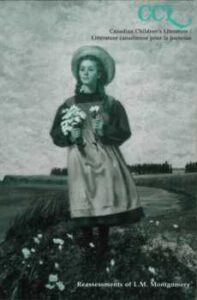
Guest Editor: Benjamin Lefebvre
This special double issue of Canadian Children’s Literature / Littérature canadienne pour la jeunesse (number 113–14), published in Spring–Summer 2004, contains English and French editorials by the guest editor, articles by Clarence Karr, Monika B. Hilder, Jennifer H. Litster, Patsy Kotsopoulos, and Lorraine M. York, and four reviews on a wide array of aspects of L.M. Montgomery studies, including fiction, life writing, television adaptation, celebrity, reception history, and intertextuality.
Editorial/Présentation
Assessments and Reassessments / Benjamin Lefebvre (6–13)
Méthodes d’évaluation / Benjamin Lefebvre (14–16)
Articles
Addicted to Reading: L.M. Montgomery and the Value of Reading / Clarence Karr (17–33)
Abstract: L.M. Montgomery was an avid reader of a wide range of printed materials, fiction and non-fiction, throughout her entire life, a self-confessed “book addict” who experienced “mental drunkenness” from her reading and who recorded her interaction with these texts in her journals and letters. Reading provided a large measure of her enjoyment at all stages of her life. The record of those experiences provides a window into both the individual reading experiences and her soul. This paper places those reading experiences in a methodological framework of reading theory and practice.
“That Unholy Tendency to Laughter”: L.M. Montgomery’s Iconoclastic Affirmation of Faith in Anne of Green Gables / Monika B. Hilder (34–55)
Abstract: This paper investigates the competitive space between L.M. Montgomery’s conscious rejection of several tenets of Christianity as frequently practiced by her own Cavendish Presbyterianism and her passionate, imaginative exploration of Christian faith in her novel Anne of Green Gables. Through humorous subversion, Montgomery dethrones the idol of an overly rational conventional Christianity in order to offer instead a compelling window on or icon of a personal living faith that is informed by passion, imagination, and wonder. Her complex viewpoint offers a rich field of inquiry into Canadian Presbyterianism at the turn of the twentieth century as well as ongoing discourses about Puritanism, the Judeo-Christian Bible, and related perceptions of children. This paper is dedicated to all people who have ever found the practice of religion deeply humorous.
“The Golden Road of Youth”: L.M. Montgomery and British Children’s Literature / Jennifer H. Litster (56–72)
Abstract: This paper explores the relationship between Kenneth Grahame’s The Golden Age and Dream Days and L.M. Montgomery’s The Story Girl and The Golden Road. By comparing each author’s description of childhood, the paper identifies developments in Montgomery’s work. It argues that the two Story Girl books are witness to Montgomery’s rejection of American literary models in favour of British ones and, in particular, British evocations of an Arcadian childhood. Montgomery may have sought different readers by diverting from the Anne of Green Gables formula; in the process, she found new ways to articulate Prince Edward Island and Canadian identity.
The Nostalgic Appeal of a Popular Place: Female Fans Interpreting Road to Avonlea / Patsy Kotsopoulos (73–97)
Abstract: What sentiments make the romance with Avonlea possible at the turn of the twenty-first century? A qualitative fan study of the television series Road to Avonlea, a rural-historical family romance set in Prince Edward Island in the early twentieth century, answers that question by testing assertions about nostalgia’s role in popular imaginings of place. Findings suggest that period setting gives fans the opportunity to be critical about the present in ways only indirectly expressed within the series, making Avonlea’s appeal as a popular place the product of a critical engagement with forms of life.
“I Knew I Would ‘Arrive’ Some Day”: L.M. Montgomery and the Strategies of Literary Celebrity / Lorraine York (98–116)
Abstract: The literary celebrity of L.M. Montgomery has been briefly summarized and memorialized, but it has not been closely analyzed as a phenomenon in its own right with connections to other systems of celebrity. Montgomery’s celebrity disrupts the typical binary understanding of celebrity as either produced top-down by hegemonic powers or created by the urgent demands and desires of an audience. Not only did Montgomery intervene in her celebrity by agreeing to participate in the commercialization of her work, but she developed a strategic and remarkably intelligent negotiation with the celebrity processes that surrounded and in part tried to define her.
Appendix: Bibliography of Materials Published on L.M. Montgomery in Canadian Children’s Literature 1975-2004 (117–20)
Reviews
Guiding Canadian Readers of Canadian Children’s Books / Roderick McGillis (121–9)
Review of A Guide to Canadian Children’s Books in English, by Deirdre Baker and Ken Setterington (McClelland and Stewart, 2003).
Windows and Words: A Description of a Scene / E. Holly Pike (129–31)
Review of Windows and Words: A Look at Canadian Children’s Literature in English, edited by Aïda Hudson and Susan-Ann Cooper (University of Ottawa Press, 2003).
Speaking of the Speechless: Babies in Canadian Literature / Janice Fiamengo (131–3)
Review of Making Babies: Infants in Canadian Fiction, by Sandra Sabatini (Wilfrid Laurier University Press, 2003).
English-Canadian Women and Literary Culture Reconsidered / Cecily Devereux (133–5)
Review of Literary Culture and Female Authorship in Canada 1760-2000, by Faye Hammill (Rodopi, 2003).
Plus Jonathan F. Vance’s review of ten historical novels for younger readers and Perry Nodelman’s review of forty picture books.